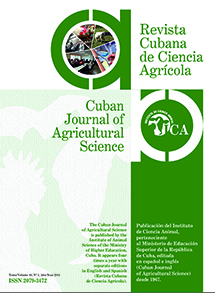Effect of calcium carbonate on solid fermentation of Solanum tuberosum post-harvest wastes, inoculated with a microbial preparation
Contenido principal del artículo
Resumen
To evaluate the effect of including calcium carbonate (CaCO3) in solid fermentation of post-harvest wastes of Solanum tuberosum (potato), inoculated with a microbial preparation, a completely randomized design was used, with three repetitions per treatment. Indicators pH, dry matter, crude protein, true protein and concentration of microorganisms were analyzed according to a 2x2x4 factorial arrangement, in which factors were fermentation time (24 and 48 h), incubation temperature (20 and 25 ºC) and percentage of inclusion of CaCO3 (0, 0.25, 0.50 and 0.75 %). For the concentration of organic acids and ammonia, a 2x2x3 factorial arrangement was used, which differed from the previous one in the percentage of CaCO3 (0.25, 0.50 and 0.75 %). It was obtained that pH increased by adding CaCO3 at 0.25 and 0.50 % and incubating at 20 or 25 ºC. Meanwhile, pH decreased with fermentation and incubation at 20ºC. Lactic acid production increased with both temperatures and during fermentation, and growth of mesophilic and lactic aerobic bacteria was favored with the inclusion of CaCO3. With fermentation, dry matter and crude and true protein percentages increased. The highest values of these
indicators were obtained with 0.50% of CaCO3 at 48 h (40.90, 19.09 and 13.8 %, respectively). However, protein synthesis was the same at 20 °C and 25 °C (72.76 %). It is concluded that CaCO3 at 0.50% favors the fermentation of post-harvest wastes of S. tuberosum with the microbial preparation, at 20 °C and 24 h.
Keywords: potato, silage, lactobacilli, additive
indicators were obtained with 0.50% of CaCO3 at 48 h (40.90, 19.09 and 13.8 %, respectively). However, protein synthesis was the same at 20 °C and 25 °C (72.76 %). It is concluded that CaCO3 at 0.50% favors the fermentation of post-harvest wastes of S. tuberosum with the microbial preparation, at 20 °C and 24 h.
Keywords: potato, silage, lactobacilli, additive
Detalles del artículo
Cómo citar
Borrás, L. M., Valiño, E., Elías, A., Martínez, J. J., Sanabria, A. M., & Becerra, M. (2020). Effect of calcium carbonate on solid fermentation of Solanum tuberosum post-harvest wastes, inoculated with a microbial preparation. Cuban Journal of Agricultural Science, 54(4). Recuperado a partir de https://mail.cjascience.com/index.php/CJAS/article/view/988
Sección
Ciencia Animal
Aquellos autores/as que tengan publicaciones con esta revista, aceptan los términos siguientes:
- Los autores/as conservarán sus derechos de autor y garantizarán a la revista el derecho de primera publicación de su obra, el cuál estará simultáneamente sujeto a la Licencia Creative Commons Attribution-NonCommercial 4.0 International (CC BY-NC 4.0) que permite a terceros compartir la obra siempre que se indique su autor y su primera publicación esta revista. Bajo esta licencia el autor será libre de:
- Compartir — copiar y redistribuir el material en cualquier medio o formato
- Adaptar — remezclar, transformar y crear a partir del material
- El licenciador no puede revocar estas libertades mientras cumpla con los términos de la licencia
Bajo las siguientes condiciones:
- Reconocimiento — Debe reconocer adecuadamente la autoría, proporcionar un enlace a la licencia e indicar si se han realizado cambios. Puede hacerlo de cualquier manera razonable, pero no de una manera que sugiera que tiene el apoyo del licenciador o lo recibe por el uso que hace.
- NoComercial — No puede utilizar el material para una finalidad comercial.
- No hay restricciones adicionales — No puede aplicar términos legales o medidas tecnológicas que legalmente restrinjan realizar aquello que la licencia permite.
- Los autores/as podrán adoptar otros acuerdos de licencia no exclusiva de distribución de la versión de la obra publicada (p. ej.: depositarla en un archivo telemático institucional o publicarla en un volumen monográfico) siempre que se indique la publicación inicial en esta revista.
- Se permite y recomienda a los autores/as difundir su obra a través de Internet (p. ej.: en archivos telemáticos institucionales o en su página web) antes y durante el proceso de envío, lo cual puede producir intercambios interesantes y aumentar las citas de la obra publicada. (Véase El efecto del acceso abierto).
